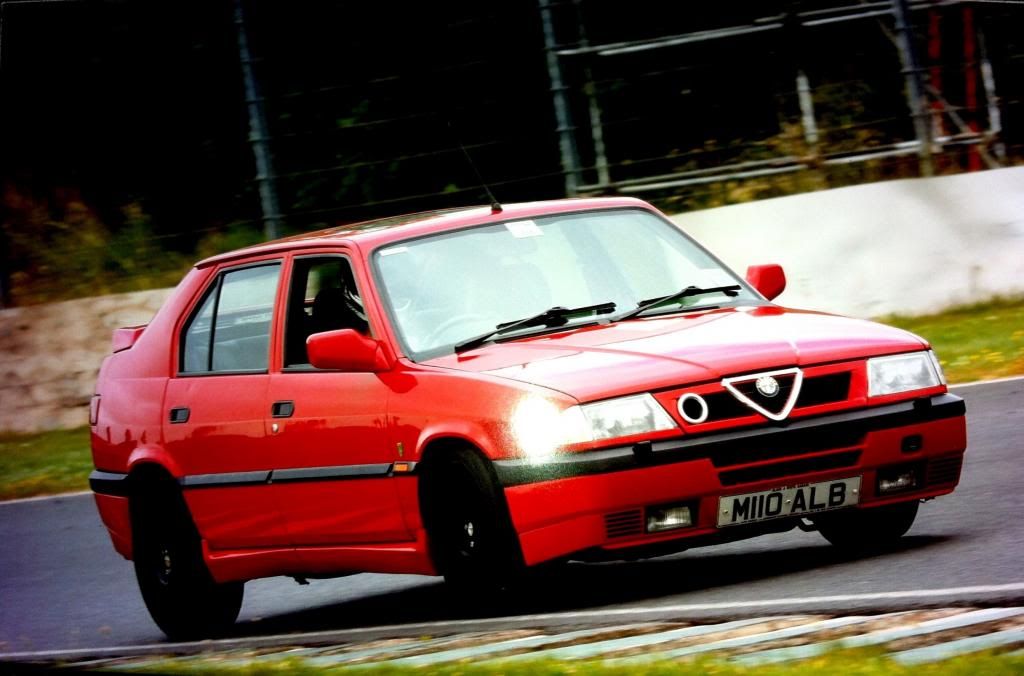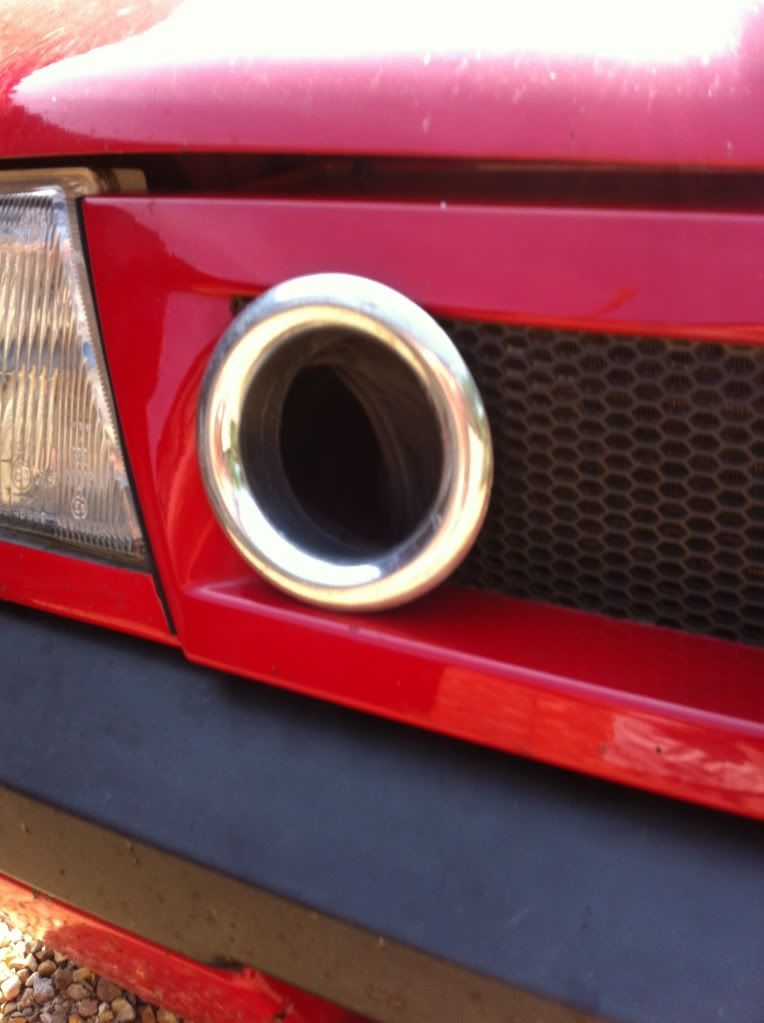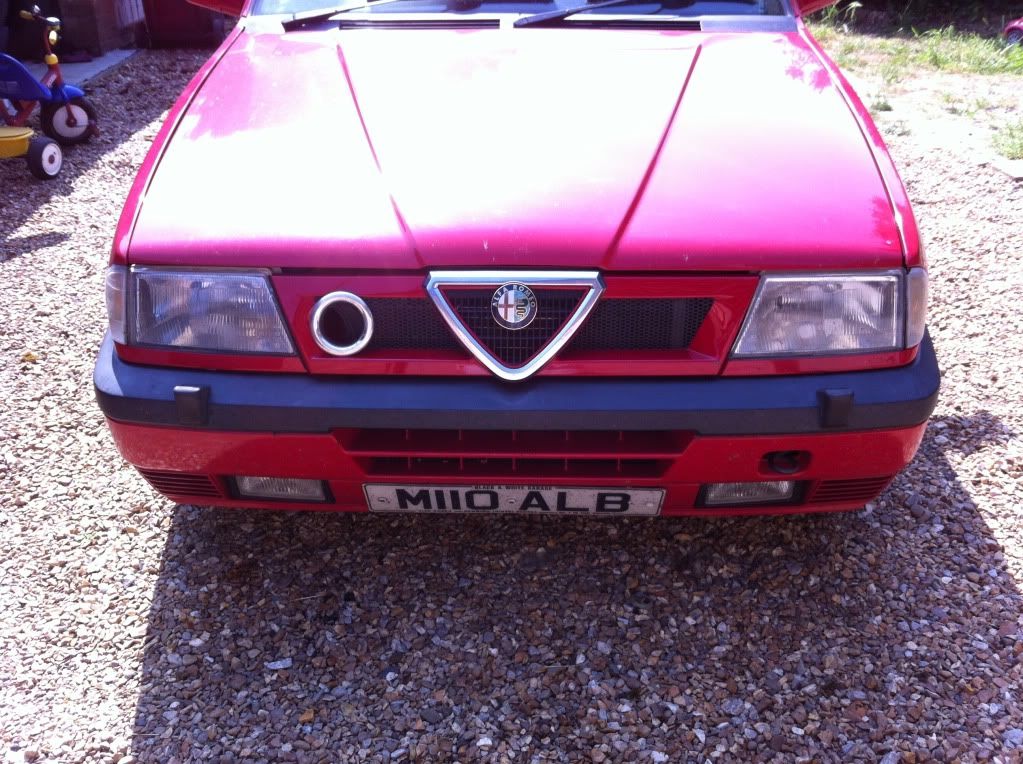| Doh. Didn't realise there was another page before posting! | |
| Nice video Neil.
Kept him off well. I imagine you missed a gear letting him by on the straight. Brings back memories of Spa |
|
The 155 has been lowered and has a chip so 160 or so HP. Driver is a taxi driver!! But very confident in his car as it was rolling a lot!! He managed to cook the brakes. I made a mistake going up to the hairpin, took the previous corners in 4th when I would have been faster in third, so he was catching up. Other than the cell phone ringing, he got so close on that last lap at the hairpin that I couldn't hold him off on the straight. Otherwise I was faster through the next long corner. It was great fun!!! |
|
| Delicious video I imagine you enjoined much the day, luky also that 33 that can run free.. uhm..the 155 was original or it have suspension re-arranged for track? I ask because the pilot seamed trust very much on his suspension/brakes/tyres, he accelerate and retarded braking to just before corners like an experienced track guy and his car remained stable.. But had a long way to chase your 33, it seams to me that most times from half corner and in the exit of the the corners you was faster ..when he pass, you was responding to cellphone..next time turn it off.. |
|
| sweeet |
|
| Well, the little red car survived Mallory.
Did really well, only 2 issues really, shifting down into second at the hairpin was not a pleasant experience, and after 10 laps, the oil temp was getting high so needed to stop and cool off. Brilliant time was had by all. Thinking we are going to Knockhill next year if any other 33 owners would like to join in. Here is a pic of the 33 in action: 
And a vid of me being chased by a very nice 155 2.0 TS 16v. See if you can see what I did wrong to let him get past!! http://www.youtube.com/watch?v=XSyVRlBuV3E&feature=youtu.be |
|
| Hi Wombat, I'm reading your post with interest, and for me the brake upgrade make sense (if one have some time for do it) Before I'd like to say some pace-full words 33 brakes are ok: it is true that original 33 brakes works, you can modulate braking quite well and have enough braking power also to block the wheels. After I have said that, on my personal taste: 1) brake pedal is quite heavy to operate (7 inch brake booster is quite small for the mass of the car), in normal use like in traffic this is fatiguing and can give you too much "alert" and "adrenaline" sensation in the traffic it is really more stressing than drive and brake on a recent car.. 2) in serious braking from high speed or repeated breaking with the small 239mm disks intended for 13 inch rims, using original alfa 13 or 14 rims that are quite a close-air design, brakes can fade or the modern pads can smoke and get glassed (unless you use "performing" pads with asbestos like the original alfa pads of '90 or some sport aftermarket pads) .. -> for track use and 1,7 16v, so quite heavy car, 284 mm front disks with 15 inch rims and 57mm oil piston opel calipers is probably best option, with enough safety range for every situation, may be (?) there are or not some complication to adjust them with the rear.. we are going to learn about some tricks from your experience.. -> for street use or smaller motors I consider interesting the 256mm front disks (ok with 14 inch rims) conversion (described in the post in the other section of this forum), no necessity to change rear drums or original brake pump (20,64 mm inner diameter for last series) and if a little more rear brake power would be necessary for balance, it is possible (before trying to adjust the brake regulator valve), change the standard drum 17mm cylinder piston with the 19mm cylinders used on older 4x4 33 models; Consider that 17mm cylinder piston for the drum I think it is equivalent for braking power to a piston for rear disk 2x-3x bigger, because they work differently (and they apply force to a bigger diameter than pads on disk) so they are strong enough, may be the major problem I think is that drum got bad ventilation respect disk I know 256mm disks option at the front is a sort of compromise, only 10% more effective radius, but you will use them with calipers with 52 mm (opel) or 54 mm (alfa) piston diameter instead of original 48 mm (alfa 33), and finally get a decent 30-50% increase in stopping power; the good part is that this option is 1,5-1,8 kg less heavier on each wheel (about 1kg the disk, 0,5-0,8kg the caliper) than the radical 284 mm disk option and you can still use 14 rims, also original ones. Ps.: I searched on a brake catalog, probably your opel front calipers where intended precisely for 284mm disks (284 mm disks where used on older 5 stud opel cars) and not for 288mm, so well done, you matches optimally calipers and disks.. |
|
| lol to joining at the same time I have concidered a big brake conversion but I would like to run 14" / 15" as larger wheels and tyres, in my opinion, doesn't aid the cars handeling and the costs for race tyres in 16" are silly money. With ducting I think my setup will be ok for track. http://www.ahmotorsports.co.uk/RaceParts.htm#33panel |
|
Yep, its all a bit of a compromise. I think there is a good reason to experiment with the original size discs to avoid the weight penalty. I reckon good quality original discs, with light weight 4 pot calipers would probably be optimum on the front. |
|||
| Well talk about brakes, try telling the sud guys that in-board brakes are a design flaw. Everyone jumps at you. I've seen sud guys going such a great job in improving the in board brakes from a crappy braking condition due to very high temperatures. 2 major flaw on the in-board brakes are direct heat transfer from the gearbox, and braking force greatly increases torsion stress at the drive shaft. Only one alfa sud guy agreed with me. That sud guy raced his sud and broke his shaft whilst braking. Car went straight. He lived to tell the tale.
Alfa Romeo themselves decided to go out board with a faster, better Sud sprint 1.7 QV. |
|
| You did a great project mate. I was toying with the idea of larger disk from a 146 TI. I ditched the idea after carrying it. I am bulimia when it comes to the 33. A very light car to begin with, seems like every 10 kg can be felt. Also due to the limited power the engine produces, the rotational mass will eat significantly into the power. brake efficiency is weight related. So I went the other path. And Al. I'll try to find the log in icon... | |
| It is interesting stuff though, so no problems hijacking.
There are many pathways to getting better brakes. Several on here have posted using better standard size front disks and good pads improves the set-up no end. I could have done that, but wanted to experiment a bit, so went the GM ATE large caliper and 155 284mm disc route. Adds weight to the front end and there is a slight but noticeable difference in the feel of the steering, but not to the detriment of handling. The braided hose thing is a bit confusing. Statistics wise, the risk should be a comparison of OE versus aftermarket braided. I have used braided on numerous cars and not had issues. Never come across an Alfa OE hose with steel braining inside though. Not saying its not the case, don't get me wrong, and not sure if my 33s still have OE hoses. The rear disc versus drum thing is an interesting argument. F1 looked into a hi-tech version of drum brakes, as they offer a lot of advantages. On the back end of the 33 though, they do offer more braking and are slightly lighter making for less unsprung weight on the back axle (marginal though). I don't have empirical figures on the rear discs versus drums, but I do know that the P4 compensator drops the braking ratio a lot more than the standard drum compensator to avoid rear lock ups. My car has a bigger front end set-up, and uses the standard 16v compensator with the discs on the back to try and establish balance. Seems to work well with plenty of rear end braking without locking up. On the overall system, I did a detailed physics analysis of the effect of bigger brakes, calipers, and master cylinder options on Berlina Sportivo. The maths are quite simple: - same master cylinder and bigger caliper pistons (more piston surface area) will give a big increase in braking force (the driving piston to reciprocating piston surface area ratio is a force magnifier for pressure in a liquid). Down side is that the driving piston has to travel further, so longer pedal travel. - Bigger master cylinder with same caliper pistons reduces the braking force (ratio goes the other way) but less pedal travel - Larger caliper size and caliper piston size allows larger disc, which is where the advantage becomes useful, as putting the brakes on at a given force, further away from the center of the axle, will give more leverage against the direction of turn. So what does this mean for the front end? I have a larger piston surface area so more force at the disc, but a larger master cylinder which starts to reduce that force but balances pedal travel. The force is still bigger than standard though. Bigger caliper requires bigger pads. Need to look at the pressure they exert on the disc, and bigger pads are actually bad as pressure is inversely proportional to surface area. When you do the maths on my set-up, the large increase in piston size, change of master cylinder, and larger pads, only give me a modest increase in pressure at the pad. However... because the disc is bigger, the leverage from this (force at the pad x distance from the center of the axle, bit of an average assuming the force works at the center of the pad) is much bigger. So, bigger brakes works on the front at the slight expense of unsprung weight. What about the back... This is much simpler if you forget the compensator for a while. Look at the piston size again. Drum brake piston size = teeny tiny. Disc brake piston size = much much bigger (still small compared to the front though!) Leverage for the discs is less as the discs are smaller than where the force is applied on the drums, but pad size is smaller (assumes that all the drum pad is doing some work). Based on the maths, rear discs can generate more braking force than drums based on some rough measurements from the 33. Now bring the compensator in, but its just a mechanism to try and balance the forces between front and back by reducing the liquid pressure in the rear circuits, so the maths still work for any given pressure. Another important consideration though. Front vented discs offer much more surface area to dissipate the heat from braking. Bigger discs equal more heat disappation, so better overall long term performance for one braking activity. Rears are a it more difficult, but should follow the same pattern. I have not measured the surface area available for heat dissipation for drums and discs. So there you go. Your challenge is to find the flaw. There was a reason why the automotive industry went to discs, and why top end cars use larger disc brakes (amongst the many manufacturing and financial compromises) If you have read all of this and are still awake. A pint of finest beer awaits you next time we meet!! |
|
| Can you sign in so I can pm you, we are hijacking the thread |
|
| About the carbon fiber bonnet? How much? I've gotten excited again since a few cars tried to race me last week... | |
| yup, mine is setup for track and when they get up to temp, wow, best brakes i've ever had nose diving is due to soft shocks and springs?? I have AHM race springs and koni sport shocks, race valved, so that shouldnt be a problem. I havent been on track yet to do a shake down as the car is still a work in progress |
|
Hi Big Al. My experience is you need the pads to match the disk. My tarox g88 works best only with tarox pads as they are designed to funtion optimally at higher temp. Re: rear bias. It's adjustable for reason of customisation. Of course if hard braking swings the tail out we'd try to have more on the frint. But I believe the factory settings gives people more nose dive issues. I have played with the settings and sent it for brake bias wheel test. The original setting only offer a little more than 10% on the rear, which is absurd. |
|||
| Hi Serpent,
I use ferrodo ds3000's with tarox SJ disks now When I lowered my ser 2, the rear sits lower and the compensator adds more braking to the rear as it is desinged to do. If anything you need to reduce braking to the rear as the back wants to step out. |
|
| The original 16V hoses are very thick. rubber sheath over steel braid. Also must factor in the diameter of the 33 rotor is not really big so parts like brake hoses take more stress than another car with big rotors for same stopping power/traction. If it was only me, it could be one in a million, but 3 cases on my side don't make it lottery anymore. Like I said, the original hoses are really great to begin with. Sorry, should have logged in so i can edit my post.. | |
| Also to add. Having rear disk brakes doesn't increase rear braking. It just has lower heat build up and lower rotational mass. Wanting more brakes behind is adjusting the brake bias, which is possible on the 33 with the lever. | |
| Big Al. I strongly recommend you try a different set of Pads to begin with. I was given some crap pads a long time ago. They fit exactly but fade horribly. Used the original oems, eliminated that problem. I used to track a lot. Taroxs rotors and pads were all i ever needed to work at higer temperatures. | |
| I'll see if I can check. But 33's only came in two types. The more common gold coloured one. If it's the slimmer black coloured ATE one, you should try it. Vast difference. I had one original brake hose with outer rubber sheath rubbed against something and worn down, exposing the steel braid. Happened a long time ago. And also after market hose bursting on the 33, at least came across 3 cases in the workshop I go to. One of which was me. Standard hoses had excellent track record so far. This alone I strongly discourage aftermarket ones. The risk is too high. I darted through a major junction. Trouble is failure occurs in instances you need to stop the most. First thing I did that improved braking on my 33 was adjust more bias to the rear. Stopping distance reduced dramatically too. | |
| Interested in your comment on the aftermarket braided hoses. I have used Hella on several cars and never had a problem, with slightly improved brake pedal feel. I have chopped several hoses in half from this 16v and the P4 I am stripping, and not come across an internal steel braid yet. Not sure if they are OEM, but interesting that you have come across some with an internal braid.
Do you have the serial number of the ATE master cylinder? Interested in what diameter cylinder it has. |
|
| Nice work. I'm sure it's plenty more satisfaction increase than braking power increase. My 33 originally came with rear disk but previous owner removed and sold it, replaced with drum. I have no issues with brakes. I'm using the black ATE brake pump which significantly increases the pressure. If I need to track it, i use tarox G88 for higher operating temperatures. They last very well also. Slight issue during cold braking. Also, NEVER use after market braided hoses. Originals hardly ever fail and they are steel baided on the inside. Many had experience bursting the after market hoses. Some lived to tell the tale(I was one of them). I had sparco hoses that failed.
I guess rear drums are so primitive I too would like to see rear disks on them. |
|

